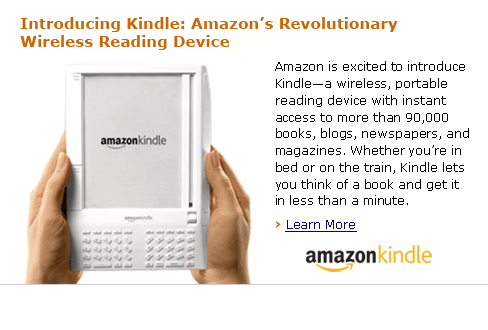Kindle: Amazon’s electronic book reader
Amazon’s new e-reader has been widely discussed this week. Most of the comments have been unflattering. Critics have gasped at the high price ($400) and commented unfavourably on the slightly dated appearance of the device. Others asked why Amazon thought it could charge for newspapers and blogs that are available free via a computer.
This isn’t the first attempt to market an e-reader. Other pocket readers, such as Sony’s, have failed to make much impression. Will Amazon overcome the early objections and turn Kindle into something worth buying? I think the answer is probably yes, and the impact on CO2 emissions might be more than trivial. Paper and card manufacture is responsible for about 4% of UK emissions. (Much of the UK’s paper is made abroad, so doesn’t show up fully in national accounts.) Getting rid of paper use is a worthwhile carbon-saving aim.
***
Electronic readers have been available for ten years or more. Early PDAs could download books via a computer. The reading experience was poor and nobody succeeded in getting customers to pay for the book. Sony’s reader was better in that it used ‘e-ink’, which can be read in bright light.
Amazon’s Kindle brings some substantial further advantages over the first generation of e-readers:
It downloads books through a mobile phone connection. Download speeds are high and the book will be available a minute or so after ordering. (The device only works on a US EVDO network.)
A large percentage of current bestsellers is available for sale, along with newspapers, journals, and blogs. All the perishable material is downloaded in the background if the user has paid a subscription.
The user has free access to dictionary definitions, Wikipedia, and can search and bookmark all the texts on the machine.
The e-reader will need charging every couple of days, a process which takes about two hours.
Word or PDF documents can be mailed to the device and shown on its screen.
It is the size of a large-ish paperback and weighs about 300g.
The press decided that that this was Amazon’s attempt to launch the equivalent of the iPhone. But the Kindle has a mediocre design and makes little attempt to market itself as as a high-status accessory. Critics could not see why anybody would pay $400 to carry books around that might be bought for $5 in an airport book store. On a more positive note, the reviewers admired the quality of the screen and the legibility of the text.
It is easy to dismiss the Kindle but eventually electronic readers will take over a substantial fraction of our paper-based reading. Early successful use will come in some obvious markets:
Any text material that is regularly updated, such as technical manuals or computer programming guides.
Books, such as legal textbooks, which would benefit from easy search, cross-referencing, and comparison.
Material of very high urgency, such as financial news.
High-income professional users will probably form the early market, rather than the general fiction reader identified in Amazon’s publicity. Many of these people may well have broadband modems for their laptops already, but the easy legibility of texts may be of advantage. Imagine a lawyer going into court. She might email much of the background material for the case on to the e-reader for rapid searching. The main legal textbooks and manuals of precedents would also be available on her reader. A good always-on e-book device would be of substantial advantage.
Or what about a university academic needing to get access to scores of different sources? Amazon’s searching technology allows easy reading of paragraphs from several books on the topic of interest. In this respect, the Kindle is a real advance over conventional computers.
Does paper matter? The manufacture of paper is a substantial contributor to national emissions. The UK uses about 13m tonnes of paper and card a year (about 200kg per person). About two thirds of this (8m tonnes) is newsprint and papers for writing and printing, including books. About half of this paper is imported and half is made in the UK.
Very approximately, a kilo of virgin paper produces 3kg of CO2 in its manufacture. Recycling saves about half of this. An increased fraction of the UK’s paper and newspaper is now recycled; the current figure is about two thirds. The declining amount of paper manufacture in the UK means that increasing amounts of the paper to be recycled is sent abroad for processing. All-in-all, the total net carbon dioxide cost of paper used in the UK is probably about 30m tonnes, much of which will be incurred abroad.
For reading matter such as newspapers, the principal CO2 cost lies in the manufacture of the paper. One close analysis of the carbon impact of direct marketing similarly puts the paper at over 90% of the total. Books will be somewhat different: one study showed that a 500g book had a CO2 cost of over 3kg, double the impact of the paper alone. At current ETS prices, the cost of this CO2 is about 5p, which probably would add about 5% to the manufacturing cost of a typical substantial paperback.
Transferring a quarter of our total reading of books, papers, marketing fliers, manuals, and office documents to an e-book reader might save approximately 7m tonnes of emissions, or about 1% of the UK total. The Kindle deserves a chance.
